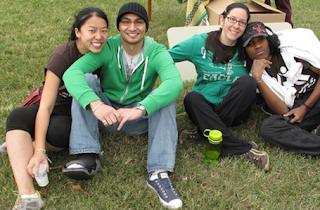Let's Talk...
Let's Talk East Baltimore
The Center in Urban Environmental Health (COEC) in collaboration with The Center for Social Concern recently held their annual Alternative Spring Break Program, Breaking in Baltimore. The purpose of the program is to expose Hopkins students to pressing social issues impacting Baltimore residents. Through volunteer opportunities, panel discussions, site visits, documentary viewings and group discussions, students learn about food justice, poverty, and urban health. For this year’s session, 12 Hopkins students were invited to learn more about environmental issues affecting Baltimore. They were accommodated in the McElderry House Bed and Breakfast in the heart of East Baltimore.
The panelists consisted of a diverse group of individuals who shared their personal views and stories of how they remembered life in their community, East Baltimore. The discussions were a reflection of a time in which they lived, worked and owned businesses-when East Baltimore was a vibrant community.
“As we each told our story, the students hungered for more… more of our ‘East Baltimore’ community, not what their eyes saw but what we once knew as community,” said Barbara Bates-Hopkins,COEC Community Relations Coordinator and native East Baltimorean.
The panel discussion was an exciting precursor to the community tour scheduled for the students with Glenn Ross, community consultant for SOURCE, a community organizer and environmental justice activist. COEC identified an innovative group of individuals to form the panel for this group discussion.
Panelists included: Michael Trush: Researcher and Professor, Johns Hopkins Bloomberg School of Public Health, Center in Urban Environmental Health, COEC, and Deputy Director Patricia Tracey: Native East Baltimorean – Johns Hopkins Bloomberg School of Public Health Center in Urban Environmental Health, COEC Staff, Barbara A. Bates-Hopkins: Native East Baltimorean - Johns Hopkins Bloomberg School of Public Health Center in Urban Environmental Health, COEC Staff, Doris Hill: Native East Baltimorean – Johns Hopkins Bloomberg School of Public Health- Institutional Review Board (IRB) Community representative member (aunt of the late Reginald F. Lewis, The Reginald F. Lewis Museum of African American History and Culture; prior entrepreneur of the Avalon Shoe Store of the historic Old Town Mall) Ella Myers: Native East Baltimorean – Johns Hopkins Bloomberg School of Public Health- Institutional Review Board (IRB) Community representative member, Steven Ragsdale: Quality and Innovation Coach, Johns Hopkins Medical Institution- years of health care experience with proven results in aligning strategy with business goals, enhancing business processes and implementing solution oriented strategies. Steven is also currently a member of the Johns Hopkins Diversity Leadership Council where he focuses attention on issues of Disparities in Medicine.
East Baltimore consists of the Northeastern, Eastern, and Southeastern districts. The Eastern District is the heart of what is considered East Baltimore. It is home to Johns Hopkins Hospital, the Schools of Medicine, Nursing and Public Health. The area is primarily African- American and consists of low-income residential neighborhoods. Entire blocks of abandoned buildings and its chronic problem with drug trafficking made this area a frequent on-site film location for the HBO series, The Wire. Old Town Mall, once one of East Baltimore’s most thriving malls, is now a symbol of urban decay.
The Center in Urban Environmental Health (COEC) in collaboration with The Center for Social Concern recently held their annual Alternative Spring Break Program, Breaking in Baltimore. The purpose of the program is to expose Hopkins students to pressing social issues impacting Baltimore residents. Through volunteer opportunities, panel discussions, site visits, documentary viewings and group discussions, students learn about food justice, poverty, and urban health. For this year’s session, 12 Hopkins students were invited to learn more about environmental issues affecting Baltimore. They were accommodated in the McElderry House Bed and Breakfast in the heart of East Baltimore.
The panelists consisted of a diverse group of individuals who shared their personal views and stories of how they remembered life in their community, East Baltimore. The discussions were a reflection of a time in which they lived, worked and owned businesses-when East Baltimore was a vibrant community.
“As we each told our story, the students hungered for more… more of our ‘East Baltimore’ community, not what their eyes saw but what we once knew as community,” said Barbara Bates-Hopkins,COEC Community Relations Coordinator and native East Baltimorean.
The panel discussion was an exciting precursor to the community tour scheduled for the students with Glenn Ross, community consultant for SOURCE, a community organizer and environmental justice activist. COEC identified an innovative group of individuals to form the panel for this group discussion.
Panelists included: Michael Trush: Researcher and Professor, Johns Hopkins Bloomberg School of Public Health, Center in Urban Environmental Health, COEC, and Deputy Director Patricia Tracey: Native East Baltimorean – Johns Hopkins Bloomberg School of Public Health Center in Urban Environmental Health, COEC Staff, Barbara A. Bates-Hopkins: Native East Baltimorean - Johns Hopkins Bloomberg School of Public Health Center in Urban Environmental Health, COEC Staff, Doris Hill: Native East Baltimorean – Johns Hopkins Bloomberg School of Public Health- Institutional Review Board (IRB) Community representative member (aunt of the late Reginald F. Lewis, The Reginald F. Lewis Museum of African American History and Culture; prior entrepreneur of the Avalon Shoe Store of the historic Old Town Mall) Ella Myers: Native East Baltimorean – Johns Hopkins Bloomberg School of Public Health- Institutional Review Board (IRB) Community representative member, Steven Ragsdale: Quality and Innovation Coach, Johns Hopkins Medical Institution- years of health care experience with proven results in aligning strategy with business goals, enhancing business processes and implementing solution oriented strategies. Steven is also currently a member of the Johns Hopkins Diversity Leadership Council where he focuses attention on issues of Disparities in Medicine.
.jpg)

